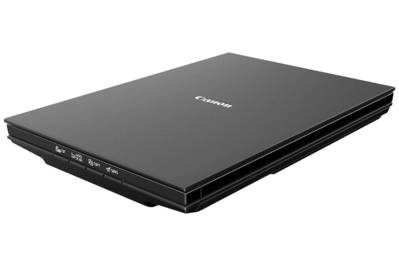
The Canon CanoScan LiDE 300 is quicker, smaller, and lighter than most competing scanners, and it produces better image quality at default settings. Despite its clunky design, Canon’s software works on both Windows and Mac and provides an array of tweakable settings to satisfy demanding image-quality purists. Setup couldn’t be simpler, since the scanner uses a single cord for both power and data, and it doesn’t even have a power button.
Its scanning resolution is good enough for most applications. While it’s not the highest-resolution scanner we tested, the LiDE 300 can scan at 2400 dpi, and we think that will be more than enough detail for most people when it comes to common office documents, photos, and even some specialty uses.
But because Canon’s scanning software refuses to save any files larger than 100 MB, you can’t scan most photos and documents at ultra-high resolution. The average 4-by-6-inch photo scanned at 2400 dpi makes a massive 381 MB JPG file, and a standard Polaroid photo comes out to 282 MB.
Its scans produce crisp text and realistic colors. Our test scans of photos at everyday resolutions like 300 and 600 dpi showed realistic color and contrast, with enhanced but not overbearing sharpness.
By default, IJ Scan Utility and the bundled, more advanced ScanGear app have sharpening (in the form of unsharp mask) turned on, but it can be turned off if you prefer a softer look. With sharpening turned on, there’s also a slightly elevated level of image noise, but we preferred that to the unnatural smoothness created by competing models’ noise-reduction algorithms. The LiDE 300 also captured office documents with the same attention to detail, rendering crisp text and vibrant but not overly saturated graphics.
It’s plenty fast. In our tests, the LiDE 300 scanned a typical black-and-white office document in about 10 seconds at 300 dpi, or 30 seconds at 600 dpi. Letter-size, glossy color photos took 12 and 41 seconds at the same resolutions. That’s much quicker than the Epson V600, which took 16 seconds to scan both text and photos at 300 dpi and 48 seconds at 600 dpi, but it’s a couple of seconds slower than the more expensive Canon LiDE 400.

Stitch mode lets you create scans larger than the Canon’s scanning area. The LiDE 300’s platen glass has a maximum scannable area of 8.5 by 11.7 inches, which is exactly what most rivals offer. If you need to scan something that’s larger than that, you can use the Stitch mode in IJ Scan Utility to capture it in pieces and then assemble the pieces into one larger file. Similarly, you can save a little time by scanning up to four smaller items (like wallet-size photos) at once and saving them as separate files.

Its physical design is extremely simple. On the front you’ll find four buttons that can be used for different quick-scan options: Scan to PDF, Auto Scan, Copy, and Send/Upload. The latter button can upload your scans to web services, including Evernote, Adobe Acrobat DC, Box, Dropbox, or OneDrive. All of these buttons can be configured to use the resolution, paper size, color settings, and post-processing options of your choice, via the Canon IJ Scan Utility. There’s also one Micro-USB port for power and data.
Flaws but not dealbreakers
Canon’s text-recognition software is mediocre. Its OCR results are much less reliable than what you’d get from the average portable document scanner and might not even keep up with a smartphone scanning app. However, if OCR is crucial to your workflow, there are third-party apps from companies like ABBYY and Adobe that will get you better results. The OCR in Epson’s Epson Scan 2 software also does a much better job.
It takes up a lot of desk or shelf space. While it’s substantially lighter and slimmer than the Epson flatbeds we tested, which are chunkier thanks to their in-lid light sources used to scan film negatives, the LiDE 300 is only a little smaller in terms of the footprint it occupies on your desk. And unlike the more expensive LiDE 400, it doesn’t include and isn’t designed for a kickstand, so you can’t position it upright to save space during use (though you can, of course, store it on its side when you’re not using it). We don’t consider this to be a serious flaw, but it’s something to consider if your desk space is limited.

During setup, Mac users should make sure to unlock the mechanism designed to prevent damage to the machine during shipping. It’s located at the bottom rear of the scanner. If it’s locked, you get an error message telling you to unlock it, but only in Windows OS. Canon’s IJ Scan Utility Lite for Mac doesn’t produce that message, so there’s no way to tell what’s wrong.
It lacks built-in wireless connectivity. Even though it’s 2023 and virtually everything in your house has Wi-Fi, this isn’t really a mortal sin, since no other scanners we tested do either. After all, you need to manually change out each piece of content that goes into the scanner, so you need to stay close to the machine. However, we’d prefer to have as few wires as possible cluttering our desks.





